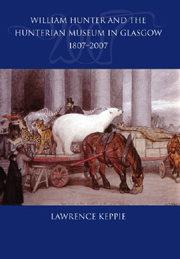Book contents
- Frontmatter
- Contents
- Foreword by Sir Kenneth Calman
- Introduction
- List of Illustrations
- Acknowledgements
- Abbreviations used in the Notes
- Dedication
- 1 William Hunter's Life and Career
- 2 Growth of the Hunterian Collection
- 3 ‘The Noblest Legacy upon Record’
- 4 A Temple of the Muses: the First Hunterian Museum in Glasgow
- 5 ‘This Place of Fascination’: the Impact of the Museum, 1807–70
- 6 A New Museum for a New University, 1870–1900
- 7 The Twentieth Century: War, Peace and Renewal, 1900–75
- 8 The Hunterian Art Gallery
- 9 Modern Times, 1975–2007
- 10 Overview: Meeting William Hunter's Intentions
- Postscript: Looking to the Future
- Notes
- Appendix: Catalogues of the Hunterian Collections
- Bibliography
- Index
- Plate section
7 - The Twentieth Century: War, Peace and Renewal, 1900–75
Published online by Cambridge University Press: 12 September 2012
- Frontmatter
- Contents
- Foreword by Sir Kenneth Calman
- Introduction
- List of Illustrations
- Acknowledgements
- Abbreviations used in the Notes
- Dedication
- 1 William Hunter's Life and Career
- 2 Growth of the Hunterian Collection
- 3 ‘The Noblest Legacy upon Record’
- 4 A Temple of the Muses: the First Hunterian Museum in Glasgow
- 5 ‘This Place of Fascination’: the Impact of the Museum, 1807–70
- 6 A New Museum for a New University, 1870–1900
- 7 The Twentieth Century: War, Peace and Renewal, 1900–75
- 8 The Hunterian Art Gallery
- 9 Modern Times, 1975–2007
- 10 Overview: Meeting William Hunter's Intentions
- Postscript: Looking to the Future
- Notes
- Appendix: Catalogues of the Hunterian Collections
- Bibliography
- Index
- Plate section
Summary
Separation and divorce: dispersal of the collections
Almost from the beginning, despite a doubling of space in the halls on Gilmorehill, there was severe overcrowding. ‘The present state of things is educationally bad … valuable property is going past the University, for donors will not give what will not be exhibited.’ Exhibits were being placed on the landing outside the Museum's main door and in the vestibule area at the foot of the grand staircase. It was agreed that dug-out canoes acquired in 1823 and 1831 could be placed against the latter's north wall, and a scheme was devised for exhibiting the Roman stones on the landing above, protected by plate glass. Some paintings too were placed on the staircase wall. Photographs of the Entrance Hall and the Main Hall by the firm of T. & R. Annan and Sons taken in 1891 confirm the crowded displays, normal for the times (see Figures 6.4, 6.5).
The entire collection had initially been housed together, whether in the High Street or on Gilmorehill. The first moves towards dispersing it came in the early decades of the twentieth century. In 1900 a new Anatomy Building had been erected at the northeast corner of the existing University complex, designed by the leading Glasgow architect Sir John J. Burnet, and in 1911–12, at the instigation of their Honorary Curator, Professor Thomas H. Bryce, the anatomical and pathological collections were transferred to it.
- Type
- Chapter
- Information
- William Hunter and the Hunterian Museum in Glasgow 1807–2007 , pp. 93 - 105Publisher: Edinburgh University PressPrint publication year: 2007



